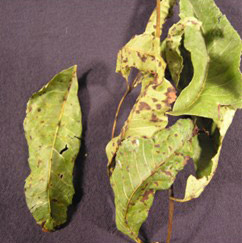Pecan Scab & Hour Calculator
Pecan scab is an important fungal disease caused by the pathogen Cladosporium caryigenum and is generally considered to be the most destructive disease of pecan in most growing regions in the United States. Without management, pecan scab can cause 50-100% losses in susceptible varieties.

Scab is favored by wet and humid conditions, especially prolonged periods of continuous leaf wetness, and can occur on leaves, twigs, and nut shucks. Young and actively growing tissues are the most susceptible to scab and become less susceptible as they mature. The disease first appears as small, dark brown to black spots, which may continue to increase in size, sometimes coalescing into large, irregularly shaped, lesions.
Infection is more often seen on the lower leaf surface, but both sides of the leaf may be infected. Leaf infection can cause a reduction in photosynthetic output, but nut shuck infection causes the majority of losses linked to scab.
When early infection of the nuts occurs, trees may experience significant premature nut drop as well as a reduction in nut size and quality. As the season progresses, initial nut scab infections become less damaging to yield and quality, with damage mostly being cosmetic, if the disease develops after shell hardening. The likelihood of nut drop increases greatly if lesions cover more than 50% of the shuck and may also result in nuts that remain on the tree or will not separate from the shuck.
Pecan scab can be managed through cultural methods such as removing fallen branches from the orchard floor and pruning trees to increase air circulation, planting scab-resistant varieties, and following a fungicide spray program. Scab severity can vary greatly from year to year, so frequent scouting of orchards and being observant of weather conditions are essential tasks to stay ahead of scab development.
See how we use SensorPush to collect weather data to determine pecan scab application timing.
When relative humidity is above 90% and the temperature is above 70° F, conditions are very favorable for pecan scab development. Each pecan variety has its own level of resistance, so a method for determining spray intervals has been developed using accumulated pecan scab hours.
Accumulated scab hours are calculated by totaling the number of hours where both 90% relative humidity and 70°F temperatures occur at the same time, resetting the calculation after each fungicide application. The model assumes that the crop will be protected for 14 days following a properly applied fungicide application. Thresholds have been set at 10 scab hours for highly susceptible varieties, 20 hours for moderately susceptible varieties, and 30 hours for less susceptible varieties.
If the threshold is met within the two-week period following a spray, it will be necessary to reapply. If the threshold has not been met, it may be possible to delay the next application until the hours have been met. It has been shown that using the scab hour model rather than simply spraying on a fixed schedule can reduce the number of fungicide applications required in many crop years.
Go to https://pecanscab.uada.edu/ to use the Pecan Scab Hour Calculator.